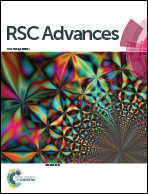Colorimetric and ON–OFF–ON fluorescent chemosensor for the sequential detection of Cu(ii) and cysteine and its application in imaging of living cells†
Abstract
An easy-to-prepare colorimetric and ON–OFF–ON fluorescent naphthol derivative 1 has been synthesized and characterized for sequential detection of Cu2+ and cysteine. Chemosensor 1 detects Cu2+ selectively in DMSO/H2O (3 : 7 v/v) by changing its UV-visible spectrum and color (colorless to yellow), leading to the formation of 1-Cu(II) complex. The resultant 1-Cu(II) complex recognizes cysteine (Cys) and the solution turns colorless with regeneration of the absorption band of 1. The detection limit of 1 for Cu2+ ion is found to be 0.27 μM, which is much lower than that recommended by WHO for drinking water (30 μM). Cu2+ ion exhibits quenching of the fluorescence intensity of 1, which is restored upon the addition of cysteine. Chemosensor 1 is used as an imaging reagent for detection of the cellular uptake of Cu2+ ion in A549 cell line (human lung carcinoma cell).


 Please wait while we load your content...
Please wait while we load your content...